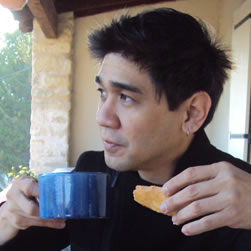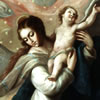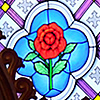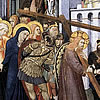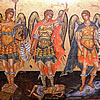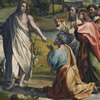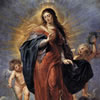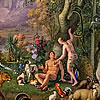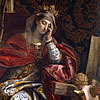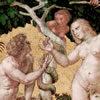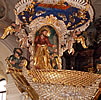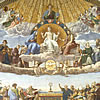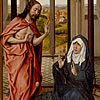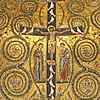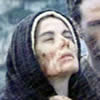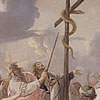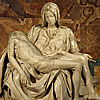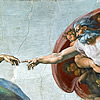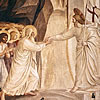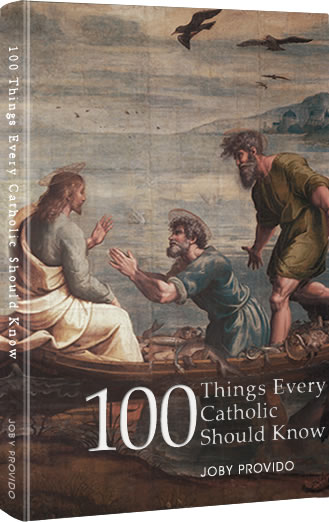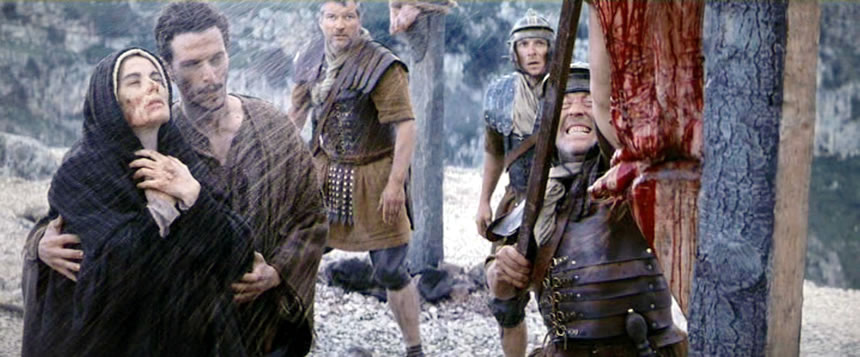

Mary, the new Ark of the Covenant, and the Blood of Christ
In the crucifixion scene in the movie The Passion of the Christ, a soldier thrust a spear on the side of Christ that ushered a spray of blood and water over him, St. John, and Mary. This excited me in a bit because it reminded me about the Ark of the Covenant. Since this Art Speaks is about the Ark of the Covenant, it would be good for us to first review what it is.
In Chapters 25 and 37 in the book of Exodus, God asked Moses to create the Ark of the Covenant. Chapter after Chapter describes God’s very exact specifications of what material and what measurements were needed to construct it. When it was finished, three things were put into it: the tablets of the Ten Commandments, which the Hebrews understood as “God’s word”; some manna, which they called “bread from heaven”; and the staff of the High Priest to symbolize him.
We continue to read that the Shekinah – the visible presence of God in the form of a cloud – hovered above the Ark of the Covenant. Scripture describes the cloud as “overshadowing” the Ark of the Covenant. It was the holiest article the Hebrews ever had, and it was eventually enshrined in what is called the Holy of Holies inside the Temple in Jerusalem. But there is an interesting episode worth mentioning in 2 Samuel 6. When King David asked that the Ark to be brought to Jerusalem, it was brought on a cart, and not carried with poles as God has instructed to Moses. The cart rocked, and the Ark was about to tip over when a man named Uzzah held it to keep from falling. Scripture tells us that God struck Uzzah and he died on the spot. (It tells us that God requires certain ways in doing things.) King David was so afraid and said, “How can the Ark of the Lord come to me?” So he let the Ark stay in the house of Obed-edom in the hills of Judea for about three months. When King David thought it was safe to proceed, he took it the rest of the way to Jerusalem as he danced before it. The Ark was enshrined inside a tent until David promised to build a house for it. This promise was fulfilled by David’s son, Solomon, in whose reign the Temple was finished.
With that as a background, the Gospel of Luke was written in such a way so that we see Mary as the real Ark of the Covenant. During the Annunciation, the Angel Gabriel invited Mary to be the mother of the Messiah. But she was perplexed because it is said she had a vow of chastity and did not know how the child was to be conceived.
And the angel said to her in reply, ‘The Holy Spirit will come upon you, and the power of the Most High will overshadow you. Therefore the child to be born will be called holy, the Son of God.’
Luke 1: 34-35
The first clue is that the word “overshadow” is used the same way the Shekinah “overshadows” the Ark in the Old Testament. When Mary consented to this invitation, God was incarnated in her womb. It becomes clear to us that she is indeed the foreshadowed Ark of the Covenant because inside of her lives Christ who is the Word of God (John 1:1 “In the beginning was the Word...”), he is also the “true bread from heaven” (John 6:32), and he is the High Priest who represents us all in his sacrifice in Calvary. During the Last Supper, when Jesus says his body and blood “is the New Covenant” it makes Mary the Ark of the Covenant in another, more literal, sense.
As if these were not enough, the Gospel continues to portray Mary as of the Ark of the Lord. When Mary visited Elizabeth, the unborn baby leapt in her womb. The word “leapt” is the same verb used to describe the dance that King David did in front of the Ark. It is a dance of joy. Then Elizabeth said, “How is it the mother of my Lord should come to me?” Finally, the Gospel of Luke tells us that Mary stayed with Elizabeth in Judea for “about three months.” The language is intended to remind us of the Ark of the Covenant again and again.
In the end of chapter 11 of the Book of Revelation, John describes to the readers that he had seen the Ark in God’s temple in heaven. To the early Christians, this was important because the Ark was allegedly taken as a trophy when the Temple of Jerusalem was destroyed by the Romans. Throughout the years, the location of the Ark was forgotten and the Ark was eventually lost and nowhere to be found.
In that chapter, St. John is about to reveal the Ark to the readers. There were “flashes of lightning, rumblings, and peals of thunder, an earthquake, and a violent hailstorm,” all of which suggest a heavenly drum roll before a climactic reveal. Suddenly St. John ends the chapter and starts a new chapter with, “... a woman clothed with the sun...” It seems so anticlimactic because just as he is about to reveal the lost Ark, he then shifts the topic to a woman.
Apparently the Bible did not originally have chapters – these were added later on as passages were referenced. So St. John did not abruptly change topic, but he was, in fact, describing the new Ark of the Covenant who is no longer a something but a someone, and that someone is Mary. It can be read continuously, like this:
Then God’s temple in heaven was opened, and the ark of his covenant could be seen in the temple. There were flashes of lightning, rumblings, and peals of thunder, an earthquake, and a violent hailstorm.
A great sign appeared in the sky, a woman clothed with the sun, with the moon under her feet, and on her head a crown of twelve stars.
Revelations 11:19, 12:1
Here is where the still of the scene in the movie becomes interesting. In the Old Testament, the Ark of the Covenant was placed in a special part of the Temple called the Holy of Holies. Only the High Priest was allowed in, and only once a year during the Day of Atonement. The faithful believed that the presence of God dwelled in a place somewhere on top of the Ark that they called the Mercy Seat. The High Priest would slay an unblemished male animal (a bull) and sprinkle some of the blood on the mercy seat. It is called the “Mercy Seat” because they believe God, after the sprinkling of the blood, dispenses his mercy from there on the Day of Atonement.
When we compare this to the crucifixion scene in The Passion, we can see that Jesus is the slain unblemished male whose blood is sprinkled on Mary, the new Ark of the Covenant. It is the death of Christ where God shows his full mercy by redeeming us himself. If there is a day of atonement that is most important, it is this day on Good Friday.
Although it is not explicitly stated in scripture that Mary was sprinkled with Christ’s blood, we know his side was pierced and blood and water flowed out (John 19:34). Saint John also tells us that “Standing by the cross of Jesus were his mother, and his mother’s sister, Mary the wife of Clopas, and Mary of Magdala” (John 19:25). If it too difficult to imagine Mary sprinkled with Christ’s blood in this scene, then maybe we can imagine her handling his bloodied body when they took it down from the cross, and also when they prepared it for burial. It would be unthinkable that she did not care for his body after he was taken down from the cross.


